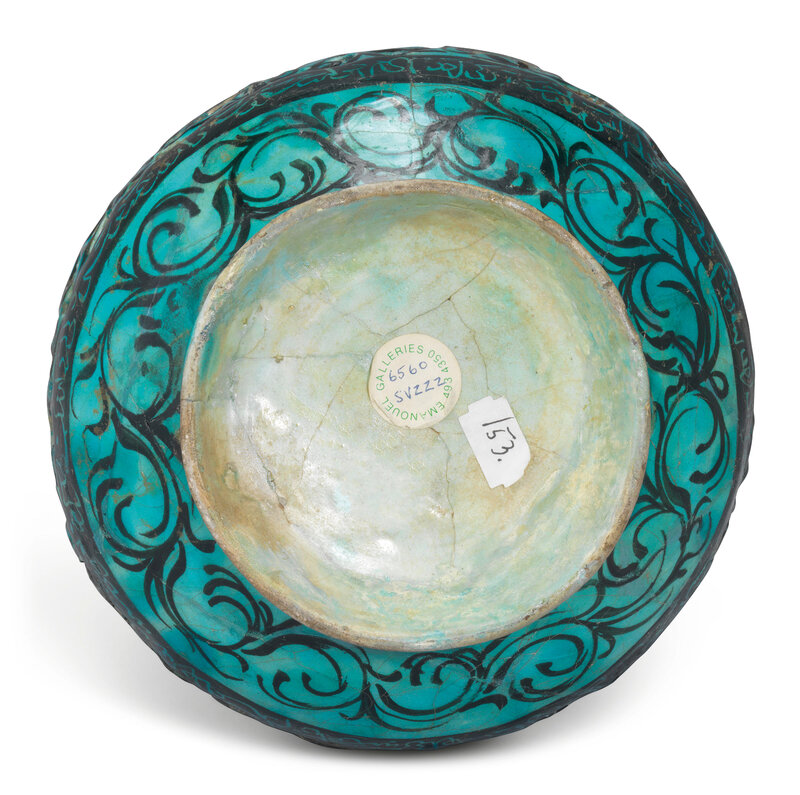A Kashan turquoise glazed reticulated cockerel-head pottery ewer, Central Iran, First quarter 13th century
Lot 8. A Kashan turquoise glazed reticulated cockerel-head pottery ewer, Central Iran, First quarter 13th century; 13 3/8in. (34cm.) high. Estimate GBP 100,000 - GBP 150,000 (USD 128,000 - USD 192,000). © Christie's Images Ltd 2020.
With spherical body and tubular neck, the mouth in the form of a cockerel's head with flaring comb, the handle in the form of a rising tapering curving tail, the inner body plain, the outer skin pierced with interlaced arabesques around seated figures with crescent motifs ringing their heads, a band of reserved naskh calligraphy engraved above and below, the neck with bold arabesques, small areas of restoration.
The Collection of the Late Dr. Mohammed Said Farsi.
Provenance: With Emanouel Antiques, London, from whom acquired between 1978 and 1979.
Note: Among the thousands of vessels made in Kashan at the beginning of the thirteenth century, the group of which the present ewer is an example stands out for its technical virtuosity. Made with a central body, a shell is applied around it which is pierced with a finely worked design before being decorated. The manufacturing of a double-shell ewer such as this requires a very high degree of confidence; the chances that there will be a disaster in the kiln are very high. It is not surprising therefore that there are very few of these pieces. In his discussion of the comparable ewer in the Keir Collection, Ernst Grube lists just nineteen known examples (Grube, 1976, no.137, pp.187-188, note 2 and pl. facing p.185). To this list, as well as the present example, can be added at least two other examples, one formerly in the Comtesse de Béhague Collection and now in Kuwait (Watson, 2004, no.N.9, p.341), and one now in the Khalili Collection (Grube, 1994, no.211, p.195). The double shell has a function as well as being highly skilled ornamentation of the ewer; a function that was also used in similarly designed metalwork pieces. The gap between the two shells was probably filled with cotton or a similar material which, when wetted, would keep the contents cool as it evaporated.
There are three forms of ewer or jug which are found that were made using this technique. The first, the least frequently encountered, has a spherical body and wide cylindrical mouth. The example in the Metropolitan Museum of Art, New York is the best known of these, and is particularly important since it is one of only two pieces in the group bearing a date (and the only one whose date is uncontested), of 612/1215 (inv.no.32.521).
The second shape, with tall cylindrical body, rounded shoulder and flaring trumpet mouth, very obviously derives its form, as well as the idea of a pierced shell, from metalwork. Examples of this form are in the National Museum, Tehran and formerly in a private Tehran Collection (Bahrami, 1949, pls.XX and XXI), in The Museum of Fine Arts, Boston (inv.no.50.3631), as well as in the Khalili and al-Sabah examples noted above, and one sold in these Rooms, 23 October 2007, lot 74.
The third form, found here, which is probably the most frequently encountered, has a rounded drop-shaped body rising to a cockerel's head mouth. The handle is formed by the tail feathers. The Keir Collection example already noted is one of these; others are in the Freer Gallery, Washington (inv.no. 49.19; Atil, 1973, no.23, pp.58-9), in the Louvre Museum, Paris (inv.no. MAO 442; Paris, 1977, no.186, p.108), in the Detroit Institute of Arts, (inv.no. 1989.34) and in the Ades Collection, London (Bahrami, 1949, pl.XIX). A somewhat squatter version of this form is in the Islamic Museum in Cairo (Mostafa, 1956, pp.42-43 and pl.60 p.38). This last is also the most puzzling in that it is dated 562/1166, a date that was re-read, probably correctly, as 657/1259 by Bahrami. These two dates therefore span the period of the early 13th century which stylistically would seem to be the most probable, reinforced by the date on the Metropolitan Museum of Art jug. There is one example of a fourth shape that relates to the third, assuming that it is not a composite vessel. In the Cincinnatti Museum of Art, it has a double gourd shaped body and a narrow tubular mouth.
The majority of the third group of ewers have a design of entwined scrolling arabesques, as seen here, painted under a turquoise glaze. In addition to this, some of them also enclose animals and human figures. The Metropolitan Museum, formerly private Tehran collection and the Boston MFA examples each enclose pairs of figures within a hexagonal lattice. While the lower registers of figures there are filled with paired confronted figures, the uppermost row on the Tehran and Boston ewers contain single figures within the lattice. The al-Sabah ewer, of similar form, contains similar single figures within a hexagonal lattice, while the double-gourd ewer in Cincinatti has very similar decoration of heavily nimbate figures, this time, as here, among arabesques. These single figures are very close to those found here, facing front, supporting a crescent which frames the face, iconography that is sometimes thought to be a personification of the moon.
Christie's. Art of the Islamic and Indian Worlds Including Oriental Rugs and Carpets, London, 2 April 2020

/https%3A%2F%2Fprofilepics.canalblog.com%2Fprofilepics%2F1%2F0%2F100183.jpg)
/https%3A%2F%2Fstorage.canalblog.com%2F03%2F02%2F119589%2F96711876_o.jpg)
/https%3A%2F%2Fstorage.canalblog.com%2F11%2F31%2F119589%2F94773502_o.jpg)
/https%3A%2F%2Fstorage.canalblog.com%2F20%2F83%2F119589%2F94772815_o.jpg)
/https%3A%2F%2Fstorage.canalblog.com%2F26%2F72%2F119589%2F75604929_o.jpg)
/https%3A%2F%2Fstorage.canalblog.com%2F59%2F60%2F119589%2F26458628_o.jpg)










/image%2F1371349%2F20240311%2Fob_875cd2_dac1749b-73d0-4aff-b50f-43b42efe9eb3.jpg)
/http%3A%2F%2Fstorage.canalblog.com%2F33%2F88%2F119589%2F128942361_o.jpg)
/http%3A%2F%2Fstorage.canalblog.com%2F94%2F98%2F119589%2F128936844_o.jpg)
/http%3A%2F%2Fstorage.canalblog.com%2F38%2F80%2F119589%2F127910584_o.jpg)